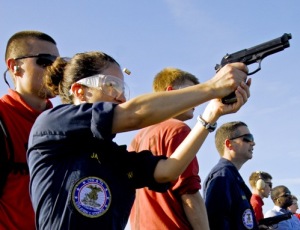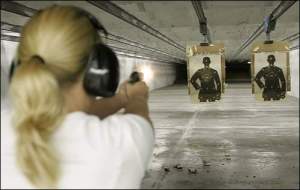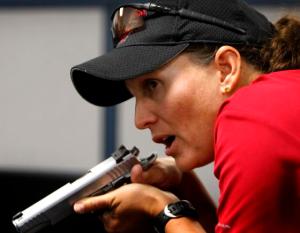By Kellene Bishop

Caliber Wars: .45 Caliber Photo c/o wikimedia.org
In a recent article I wrote, quite a few opinions were given about the appropriate caliber for self-defense. There are many macho opinions dished out on the caliber wars. But as a woman and a professional instructor I am constantly waging war on the misinformation dispensed to women on this matter.
Ironically, in spite of this site being primarily for the benefit of women, we have a LOT of male readers. I don’t intend to offend any of these male readers when I say that the majority of the bad advice on “appropriate calibers” is given by men to women, and in my opinion, it’s a BIG reason why more women don’t embrace the ownership and use of a firearm. The good news is that I’m certain that when men dispense this misinformation they certainly aren’t doing so for a diabolical reason. I’ve talked to too many of these well-intentioned men over the years on “caliber wars” and have realized that ultimately they have a genuine interest in the safety of the women who are about to embark on gun ownership. Regardless of their good intentions though, this unfortunate myth is still dispensed regularly. And it goes as follows:
“Be sure that you have a caliber with a “4” in it.”
“Don’t rely on a 9 mm. It won’t save your life.”
“Anything less than a .40 caliber is useless.”
“Practice with a .22 or a .9, but be sure to carry a .40 or better.”
There are many versions of this advice freely dished out on thousands of blogs and in classrooms all over the U.S., but they are WRONG, pure and simple, for several reasons.

Lt. Yamile Jana Shoots a 9mm. Photo c/o northshorejournal.org
First, let’s understand where they myth comes from. Many women opt to begin with a 9 mm handgun primarily due to the grip and recoil of the firearm. A 9 mm typically has much less of a kick than a higher caliber. But women often hear from their well-meaning, gun-toting friends that a 9 mm is useless. This myth is perpetuated because of a handful of well-publicized instances in which a criminal was NOT stopped promptly in spite of being shot several times with a 9 mm. Yes, it’s true that a drug-crazed individual is not easily fazed by a 9 mm shot. But it’s not the caliber that is at fault. It’s the PLACEMENT of the bullet.
Don’t tell me that 9 mm is useless. A 9 mm to the forearm may be useless whether or not the perpetrator is on drugs or embroiled in rage. But a 9 mm to the center of the head or heart will stop a tyrant regardless of the quality of the drugs he/she is on. The myth insinuates that a .40 or .45 caliber does not require accurate placement. Clearly even if I manage to hit an attacker with a .50 caliber round on their pinky finger, it’s going to do very little to bring the confrontation to a halt, right? You simply can’t count on the caliber to bring you safety. You must rely solely on your target skills.
Grip, recoil, and competency all come into play when honing your target skills. A chosen caliber should merely be the result of these aspects, not the determining factor of them.
Additionally, consider the capacity aspect of a firearm. With a smaller caliber firearm I typically have more opportunities to hit my target directly than I do with higher caliber.
This is not to say that women are “sissies.” If a 9 mm were truly a “sissy gun,” then our nation’s law enforcement agencies would be run primarily by cowards. Plenty of my students, male and female have opted for 9 mm, while others have chosen .40 or .45 caliber. It’s not a self-defense issue. It’s a personal preference issue. But in most instances, my female students never would have started shooting if a .40 or .45 had been their only option. If you’ve got too much kick in a firearm, you lose your skill. If there’s too much required grip, you lose your effectiveness as well. This is exactly why I’ve recommended the grip as the number one concern in selecting a firearm in previous articles. The less a woman has to recover from the kick-back in her firearm, the more shots she can take. Even a .22 caliber is better than a woman having NOTHING to defend herself. And that is the primary goal of this site—to train and educate women how to appropriately defend themselves with a firearm.
Here are a couple of facts to be considered:
- Professional (and military) assassins have long elected to use a .22 caliber rifle or handgun.
- Law enforcement agencies all over the U.S. use a 9 mm as a standard issue.
- There have actually been several instances in law enforcement where even .40 and .45 calibers were ineffective in stopping a criminal—not because of the caliber, but because of the ineffective placement of the round.

Woman Practicing At the Range. Photo c/o midwestdefense.com
The reason why I fiercely advocate this point is because many women hesitate to shoot a .40 caliber. They are much more successful in their shot placement when shooting a smaller caliber. Thus it’s shameful to have a woman stopped or frustrated in her pursuit of gun ownership because some macho, misinformed man tells her that a strong caliber (that knocks her on her butt when she shoots it) is useless. One thing that men simply don’t realize is that women are physiologically more sensitive to the loud bass sound of the bullet igniting than men are. Women are literally more affected by the sound of a .40 caliber+ than men are. The sound resonates through them longer than it does in men. As such, the sound literally rattles a woman. Thus high caliber firearms are uncomfortable for them to shoot initially. Do you really think someone is going to practice with a firearm that they are not comfortable with or that frightens them? No. So if they do listen to their .40 caliber friends, all they end up doing is A) not moving forward with gun ownership, or B) acquiring a .40 caliber+ firearm and just putting it away, allowing themselves to be lured with a false sense of security. Is that really in the best interest of a person who is considering taking on the responsibility of firearm self-defense?
Finally, on dispelling these common myths, practicing with a firearm other than the one you intend to use qualifies as “dumb squared.” Practice with what you are going to use for self-defense. Period. An element of surprise can only be suitably conquered by mental and physical practice to combat such an element. The last thing you need when suddenly confronted with an attack, robbery, nighttime break-in, or worse, is a millisecond of doubt that occurs, causing you to question whether or not you will be able to use your firearm since it’s not the one you’ve been practicing with.
Here’s one final thought on this topic. Five years ago my own mother took her life with a teeny tiny little .22 Derringer. So many men would have me believe that such a firearm is useless for anything other than rabbit hunting. Mom’s death had nothing to do with the caliber. It was all about the placement, folks. So, well-meaning gun owners, PLEASE stop spreading the myth that a 9 mm is useless. Let’s identify the real culprit. A poorly practiced shooter is what’s really useless to provide self-defense. Let the caliber wars cease.
Copyright 2009 Kellene Bishop. All rights reserved. You are welcome to repost this information so long as it is credited to Kellene Bishop.
Filed under: Ammo, firearm education, firearms / guns, police, self defense, women and guns | Tagged: .40, .45, 9 mm, bullet, caliber, caliber .22, caliber wars, firearm, grip, gun, law enforcement, myths, recoil, self defense, women | 21 Comments »
 Being in a bit of a hurry, I zipped through a school zone without paying attention to my speedometer. After getting midway through the school zone, I slowed down, but if there was a police car watching for me or other speeders I most likely would have been pulled over for speeding.
Being in a bit of a hurry, I zipped through a school zone without paying attention to my speedometer. After getting midway through the school zone, I slowed down, but if there was a police car watching for me or other speeders I most likely would have been pulled over for speeding.





















 In addition to the callous approach the police departments employ in reporting rape statistics to the FBI, “shame” also has a lot to do with many women not reporting such attacks. Alcohol consumption and drug abuse are often familiar prequels to rape, and no women would want to be labeled as an abuser or out of control. And due to natural side effects of substances, it’s common the victim is entirely unaware of what, if anything at all, even happened. Also, in some micro-cultures which have filtered into the U.S. from regions worldwide, rape victims are inexplicably seen as dirty, shamed, and of less worth to their families, recognized as being at fault for having lead-on the attacker. Having to relive the horrors of the incident to fill out a report and even testify in court understandably seems too much to handle. Ironically, many take an even more difficult path which requires silence, but ultimately does more damage emotionally, as well as physically and subsequently financially.
In addition to the callous approach the police departments employ in reporting rape statistics to the FBI, “shame” also has a lot to do with many women not reporting such attacks. Alcohol consumption and drug abuse are often familiar prequels to rape, and no women would want to be labeled as an abuser or out of control. And due to natural side effects of substances, it’s common the victim is entirely unaware of what, if anything at all, even happened. Also, in some micro-cultures which have filtered into the U.S. from regions worldwide, rape victims are inexplicably seen as dirty, shamed, and of less worth to their families, recognized as being at fault for having lead-on the attacker. Having to relive the horrors of the incident to fill out a report and even testify in court understandably seems too much to handle. Ironically, many take an even more difficult path which requires silence, but ultimately does more damage emotionally, as well as physically and subsequently financially.  According to the justice department, it’s rare that attackers use extreme force or brutality during the rape, even though psychologists believe it to be an act of dominion and power. Consequently, it’s rare that there is an abundance of physical evidence surrounding the attack. This is another reason why more rapes aren’t reported by victims and police departments, and why more perpetrators aren’t taken to court. Without physical evidence, and because of the commonality of alcohol and drug abuse during the act, the charge seemingly amounts to little more than a victim’s personal vendetta against her attacker. It’s her word against his, and he’s innocent until proven guilty.
According to the justice department, it’s rare that attackers use extreme force or brutality during the rape, even though psychologists believe it to be an act of dominion and power. Consequently, it’s rare that there is an abundance of physical evidence surrounding the attack. This is another reason why more rapes aren’t reported by victims and police departments, and why more perpetrators aren’t taken to court. Without physical evidence, and because of the commonality of alcohol and drug abuse during the act, the charge seemingly amounts to little more than a victim’s personal vendetta against her attacker. It’s her word against his, and he’s innocent until proven guilty.